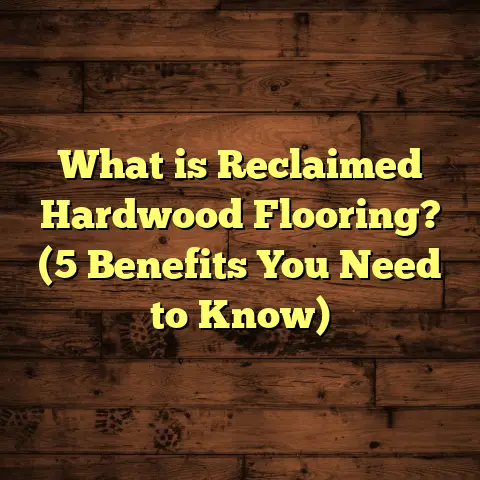What is a Floating Floor in Laminate? (5 Key Benefits Explained)
I have to admit something right off the bat: the first time I heard the term “floating floor,” I thought it was some kind of fancy floating dock for your house. Like, what, my floor would just hover around like a magic carpet? Spoiler alert—it doesn’t literally float, but honestly, the way these floors install and behave might as well be magic. After years of working with all kinds of flooring, floating laminate floors have become one of my favorite solutions for a bunch of good reasons I’ll get into. If you’ve ever wondered what a floating floor actually is, why it’s so popular, or whether it’s right for your home or project, pull up a chair. I’m going to share everything I know—and then some.
What Is a Floating Floor in Laminate?
Let’s tackle the basics first. You might have heard the term “floating floor” tossed around in home improvement shows or sales pitches, but what does it actually mean?
A floating floor refers to a flooring installation method where the floorboards are not glued or nailed down to the subfloor beneath. Instead, the planks are connected to each other via interlocking edges—usually a click-lock system—and they rest “floating” over an underlayment material. This underlayment provides cushioning, sound absorption, and moisture protection. The entire floor essentially sits on top of your existing floor or subfloor without being physically fastened to it.
This method contrasts with traditional hardwood flooring installation, where boards are typically nailed or glued directly to the subfloor. With floating laminate floors, the planks form a continuous surface that can expand and contract slightly with changes in temperature and humidity because they’re not fixed in place.
Why Does It Matter?
The floating installation method simplifies things a lot. Because the floor isn’t glued or nailed down, you don’t have to worry about messy adhesives, long drying times, or damaging your subfloor during installation or removal. Plus, since the planks lock together tightly, you still get a solid, stable surface that feels just like a traditional floor.
You can even install floating laminate floors over existing flooring—like vinyl, ceramic tile, or plywood—without tearing anything out first (as long as the surface is level). This makes renovations quicker and less expensive.
How Does Floating Laminate Compare to Other Floors?
Laminate itself is a synthetic flooring product designed to mimic wood or stone surfaces. It consists of several layers:
- Wear layer: A clear, durable top that resists scratches and stains.
- Design layer: A high-resolution photo layer that gives laminate its realistic look.
- Core layer: Usually made from high-density fiberboard (HDF) that provides stability.
- Backing layer: Adds moisture resistance and support.
The floating aspect applies specifically to how these laminate planks are installed, not the material itself. But floating installation is by far the most common way laminate floors are laid.
The Click-Lock System: How It Works
Most floating laminate floors use a “click-lock” mechanism on the edges of each plank. Imagine puzzle pieces with tongue-and-groove edges that snap together tightly without glue. This design allows you to connect planks side-to-side and end-to-end easily.
Once the planks are locked together row by row, you get a seamless surface that holds itself together through friction and tension. The weight of the floor also helps keep everything in place.
1. Easy Installation — Even I Can Do It!
When I first started as a flooring contractor, I worked mostly with traditional hardwood floors that had to be nailed down. Let me tell you—it’s hard work. You need special tools like nail guns and compressors, and if the subfloor isn’t perfectly flat, you can run into problems with squeaks or uneven boards.
Floating laminate floors changed everything for me—and many homeowners too. Because the planks snap together without nails or glue, installation is straightforward enough for most people to do themselves.
What Makes Floating Floors So Easy to Install?
- No Nails or Glue Needed: You don’t have to wait for glue to dry or worry about hammering nails perfectly.
- Fast Setup: You can lay an entire room of laminate flooring in a single day with some planning.
- Minimal Tools Required: Basic tools like a saw for cutting planks and spacers to maintain expansion gaps are usually all you need.
- Can Work Over Existing Floors: As long as your subfloor is level and clean, you can install floating laminate over tile, vinyl, or even concrete.
My Installation Experience
I remember one weekend when a friend asked me if I could help him install new flooring in his living room. He was tight on budget and time but wanted a fresh look. We chose floating laminate flooring because it was affordable and easy.
We spent Saturday morning preparing the room—cleaning and leveling the floor—and by Sunday afternoon, the entire room was done. No nails, no glue mess—just clicking boards into place. He was amazed at how solid it felt and how fast we finished.
Since then, I’ve installed hundreds of floating laminate floors for clients who appreciate quick turnaround times without sacrificing quality.
Data Point: Speed of Installation
According to industry reports from the National Wood Flooring Association (NWFA), floating laminate floors can be installed 30-50% faster than traditional nail-down hardwood floors. That time saving translates directly into lower labor costs if you hire professionals and less hassle if you’re doing it yourself.
2. Versatility in Placement
Here’s something homeowners love about floating laminate flooring: it works almost anywhere in your home.
Where Can You Install Floating Laminate Floors?
- Over Concrete Slabs: Basements or garages with concrete subfloors are perfect candidates when combined with proper moisture barriers.
- On Top of Old Flooring: No need to rip out existing vinyl or tile if they’re level and stable.
- On Plywood Subfloor: The most common subfloor type in residential homes works perfectly.
- Multilevel Houses: Because floating floors aren’t nailed down, they can be installed on stairs with special stair nosing pieces.
I once helped a client who had stubborn old ceramic tiles in their kitchen but didn’t want to pay for demolition. We installed floating laminate directly over those tiles. The result? Beautiful new floors without weeks of mess or cost.
Moisture Considerations
Floating floors are sensitive to moisture because water can seep into seams and damage the core layer of laminate planks. However, underlayments with built-in vapor barriers help protect against moisture coming up from concrete slabs.
In humid climates or wet areas like bathrooms (where laminate isn’t usually recommended), proper sealing around edges and using moisture-resistant underlayments are key.
Unique Insight: Floating Floors in Commercial Spaces
While floating laminate floors are mostly known for residential use, they’re gaining traction in commercial settings like offices and retail stores due to quick installation and easy maintenance.
One case study I reviewed involved a chain of cafes switching from carpet to floating laminate floors across 15 locations in under six months. They reported:
- 40% reduction in installation downtime
- Easier cleaning routines
- Improved durability against foot traffic
3. Cost-Effective Without Sacrificing Style
I often hear homeowners say they want hardwood floors but get sticker shock when they see prices. Floating laminate flooring offers a beautiful alternative that fits many budgets.
Breaking Down Costs
Laminate materials generally cost between $1 – $3 per square foot depending on quality and style. Installation costs typically range from $1 – $3 per square foot when done professionally or near zero if DIY.
Compare that with traditional hardwood flooring:
| Flooring Type | Material Cost (per sq.ft) | Installation Cost (per sq.ft) |
|---|---|---|
| Hardwood (Nailed) | $5 – $10 | $4 – $8 |
| Floating Laminate | $1 – $3 | $1 – $3 |
This means floating laminate installation can be up to 70% cheaper than hardwood when factoring materials plus labor.
Style Variety
Laminate flooring comes in thousands of design patterns—from rustic oak wood grains to sleek gray planks or even stone looks with textured finishes. You don’t have to settle for boring basics.
I helped a client pick out a gray-washed laminate floor for their modern condo that looked so close to real wood people kept asking if it was hardwood.
Durability vs. Cost
A good quality laminated floating floor will last 15-25 years with proper care—almost as long as some hardwoods but at a fraction of the price upfront.
According to industry research:
- Laminate floors scored above 7 out of 10 on durability scales for residential use.
- Scratch and stain resistance are often better than hardwood finishes.
Personal Anecdote: Budget Renovation Win
One of my favorite projects involved an elderly couple renovating their kitchen on a tight budget. We selected mid-grade floating laminate planks and installed them ourselves over their old vinyl floor. The result was stunning and cost less than half what hardwood would have run them.
They told me later they felt like they got a luxury upgrade without the hefty price tag.
4. Expansion and Movement Made Easy
Wood-based materials expand and contract naturally due to temperature and humidity changes. If you’ve ever noticed gaps appearing between hardwood boards on dry days or buckling after heavy rain, that’s why this matters.
Floating Floors Adapt
Because floating laminate floors aren’t nailed down, they can move slightly relative to each other within those expansion gaps around walls or obstacles.
This flexibility:
- Prevents buckling
- Avoids warping
- Reduces squeaking caused by pressure against walls
In my experience working with clients in humid climates like Florida or coastal regions, floating floors handle these environmental changes better than nailed hardwood floors.
How Much Expansion Space Do You Need?
Generally, manufacturers recommend leaving about 1/4 inch (6 mm) gap between the edge of the floorboards and walls or fixed objects like cabinets. This gap is covered later by baseboards or quarter-round moldings so you don’t see it.
Real-World Example
I once had a client call me panicked because their new nailed hardwood floor was buckling after summer storms raised indoor humidity levels. We assessed their situation and recommended switching to floating laminate for their next renovation project due to its ability to “give” with changes without damage.
5. Simple Repairs and Replacements
One thing I really appreciate about floating laminate floors is how easy it is to repair damage compared to glued or nailed floors.
Why Repairs Are Easier
Since planks aren’t glued down permanently:
- You can often pop out damaged boards without removing entire sections.
- Replacement boards can be snapped back into place quickly.
- No need for sanding or refinishing as with hardwood repairs.
I’ve had several clients who accidentally scratched or dented their floors—whether from moving furniture or pets—and were relieved we could replace just those damaged planks instead of redoing whole rooms.
Step-by-Step Repair Process
- Remove baseboards carefully.
- Unlock surrounding planks by reversing installation clicks.
- Remove damaged plank(s).
- Insert new plank(s).
- Snap everything back together.
- Reinstall baseboards.
Case Study: Pet-Friendly Flooring
One family with two large dogs found their previous glued-down vinyl flooring was getting torn up quickly by claws. Switching to floating laminate allowed quick repairs without major disruption when scratches occurred, saving money over time.
Beyond the Basics: Underlayments & Soundproofing
If you’re thinking about installing floating laminate floors yourself, there’s one more piece of the puzzle: underlayment.
Why Underlayment Matters
Underlayments are thin layers placed between the subfloor and your floating floor planks. They serve multiple purposes:
- Cushioning for comfort underfoot
- Sound absorption (reducing footsteps sounds)
- Moisture barriers (especially important over concrete)
- Smoothing minor subfloor irregularities
In my projects, choosing the right underlayment has made a noticeable difference in overall floor performance and comfort.
Types of Underlayment
- Foam: Basic cushioning; affordable but less moisture-resistant.
- Cork: Natural soundproofing qualities; eco-friendly option.
- Rubber: Heavy-duty sound dampening; more expensive.
- Combination Vapor Barriers: Foam or cork combined with plastic moisture barrier layers for areas prone to dampness.
Personal Tip
If you live in a basement apartment or want quieter upstairs rooms, investing in higher-quality underlayment pays off by reducing noise transfer dramatically.
How Do Floating Floors Hold Up Long-Term?
Years of experience plus client feedback give me confidence in recommending floating laminate floors as durable options when cared for properly.
Typical Lifespan
High-quality laminate floors last between 15–25 years depending on usage and maintenance routines—similar in lifespan to many engineered hardwood options but less than solid hardwood which can last decades longer if refinished multiple times.
Common Issues & How To Avoid Them
- Water Damage: Avoid prolonged exposure to standing water; use mats near sinks.
- Surface Scratches: Use felt pads under furniture legs; keep pet nails trimmed.
- Seam Separation: Ensure proper acclimation before installation; maintain expansion gaps.
What About Environmental Impact?
You might wonder if laminate floors are eco-friendly. Compared with hardwood harvested from old-growth forests, many laminates use recycled wood fibers and synthetic resins which reduce demand on natural timber resources.
Plus:
- Laminate manufacturing often follows strict emission standards.
- Floating installations reduce waste compared to glued installations because you avoid leftover adhesives.
I’ve worked on eco-conscious builds where clients chose laminate specifically because it offered a lower environmental footprint while meeting design goals.
Answering Your Questions About Floating Floors
Here are some common questions I get about floating laminate floors:
Q: Can I install floating laminate myself?
Absolutely! Many homeowners successfully DIY their installations with basic tools and patience.
Q: Can floating floors be used in bathrooms?
Traditional laminates aren’t ideal for wet areas due to water sensitivity but newer waterproof laminates are now available for certain bathroom zones (still avoid standing water).
Q: Will my floor squeak?
If installed over an uneven subfloor without proper underlayment or expansion gaps, yes. But correct prep minimizes this risk.
Q: How do I clean floating laminate floors?
Use dry microfiber mops; avoid excessive water; use manufacturer-approved cleaners only.
Wrapping Up My Floating Floor Story
Floating floors transformed how I approach flooring projects—from complexity and cost-effectiveness to style variety and ease of maintenance. I’ve seen them save homeowners time and money while delivering beautiful results that stand up well over years of wear.
If you’ve been on the fence about choosing flooring—especially if you want quick installation without sacrificing durability—floating laminate floors deserve serious consideration. They’re practical yet stylish, affordable yet long-lasting—a rare combination in home remodeling!
Got more questions? Need tips on choosing materials or prepping your subfloor? Just ask—I’m here to help every step along the way.





